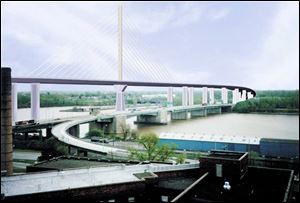
Sensors help UT engineers, others gauge changing conditions
6/17/2007
A rendering in 1999 offered a view of what the cable-stayed bridge concept might look. A local task force reviewed possible locations for a new Maumee River crossing and whether it should be a bridge or a tunnel.
Concrete moves.
It is one of the hardest concepts civil engineers try to get across to people. And it s what researchers with the University of Toledo and the University of Cincinnati are measuring on the Veterans Glass City Skyway.
The "itty bitty" amounts that concrete moves is measured in millionths of an inch, said Douglas Nims, associate professor of civil engineering at UT.
"Concrete doesn t respond fast," Mr. Nims said. "Concrete keeps changing its shape over time."
To keep tabs on the bridge over time, the university research team attached sensors to the steel skeleton of the bridge sections that were then covered in concrete. The sensors, about 32 of them in 11 different areas of the bridge, will measure the temperature and stress on the concrete in which they are imbedded.
Traffic on the bridge can cause torsion and stress on the concrete, and changes in weather can cause it to expand where the sun hits it and contract in shady areas where the temperature is cooler, Mr. Nims said.
"There are no dangers of the bridge collapsing or anything," Mr. Nims assures. "It s a heavy, stiff bridge."
There were two types of sensors paired together in every location to get the most accurate information.
The bonded electrical resistance strain gauge made by Vishay Micro-Measurements is a flat rod that measures data instantaneously. The other, a vibrating wire gauge made by Geokon, is a cylinder device that takes measurements more slowly but is not subject to temperature gradients.
There are nearly 160 channels of instrumentation on the bridge and only one gauge has failed during the course of construction, Mr. Nims said.
"Our survival rate is outstanding and all our data is good," he said. "Everything so far has been exactly as it should be."
The researchers are not only studying the deformations in concrete but also vibration of the stay cables on the bridge.
There are accelerometers the size of the tip of a thumb attached to four stay cables to measure the vibrations, which are occurring constantly, Mr. Nims said.
The data from the instruments on the bridge are transmitted through cables in the median wall to a data acquisition system at the bridge site. It comes in to the research team as lines of letters and numbers that don t really mean anything until plugged into a program that converts it to charts and other measurable forms of information.
About $588,000 was invested in the research project, with the majority, about $438,000, allocated from the bridge project fund and an additional $150,000 from the Ohio Department of Transportation s office of research and development, ODOT spokesman Andrea Voogd said.
"The intent of this project is to monitor the long-term health of the bridge," said Jeff Baker, construction project manager with ODOT. "At any point in time and without doing a real invasive investigation, you can come back in and say the state of the stress of the bridge hasn t changed and the stress of the state of the stays hasn t changed.
"It allows you to check the health of the bridge globally."
The University of Toledo crew led the first phase of the project with the installation of the sensors during construction.
The University of Cincinnati crews will do more work with Phase Two, which is conducting tests over the first year to see how the bridge responds, said Victor Hunt, research assistant professor in electrical engineering at Cincinnati. "We re playing nice and sharing the load," he joked.
The schools have been working with ODOT for years and hope to work with the transportation department for the long-term maintenance of the bridge using the sensors, Mr. Hunt said.
"In addition to using their eyeballs, it provides another measure of the bridge s performance which doesn t rely on subjectives," Mr. Hunt said.
The team is compiling reports of their research for ODOT, and a number of faculty and students involved are writing academic papers.
Contact Meghan Gilbert at:
mgilbert@theblade.com or
419-724-6134.